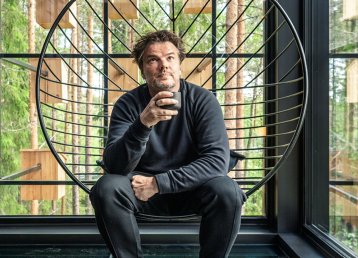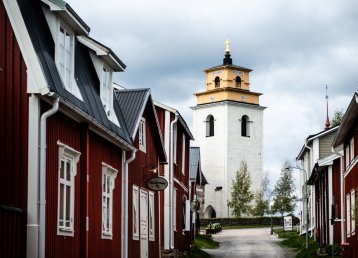One afternoon in october, I’m stopping at what was once the model community of Laver, in the Municipality of Älvsbyn. In the middle of the forest stand what remains of an industrial project that was at the absolute forefront of development, but was soon dismantled and vanished.
Laver, which existed from 1936 to 1947, was one of Sweden’s first communities with district heating, running water and electricity in every home. A sign in the woods proclaims: ‘Community Centre’. Another sign tells us where the school once stood. All that remains of the model community are the foundations upon which the houses once stood. When the ore wasn’t profitable to mine anymore, the mining company quite simply moved the village of Laver. The village’s community centre is now in Överklinten, outside of Robertsfors. Homes were loaded onto trailers and hauled to the led mine in Laisvall, farther inland.
In some way, this is a sign of a functioning circular economy, but in many other ways indicative of the price people pay for living on a frontier. On an information board in the forest are the words of the former site manager, Eric Wesslau:
“Now, the company does not exist any more and the forest will reclaim its lost domain where, for a few restless years, so much laborious work was done. One may hope that the closure will not leave too many scars.”
A price to be paid
New development and decommissioning, start and finish, open and close; always on the move as resources dwindle and projects reach completion. Life as a railway navvie or a miner, a lumberjack or a hydrodam worker; at the centre of the action, if only for a moment, but also on the far reaches of civilisation.
From Gammelstad in Luleå to the urban relocation of both Kiruna and Gällivare, Arctic Sweden has become accustomed to the creation, moving and shutting down of communities. Perhaps this is a price that must be paid? Could this have influenced the temperament of the people who live here? Its ranking on the EU Social Progress Index attests to the high level of social progress among the people who inhabit the region known as Övre Norrland. While the EU SPI average is 66.7 and Sweden as a whole ranks 82.4, Övre Norrland, Sweden’s Arctic region, scores an impressive 85.1.
"The pioneer spirit which exists, but which does not always establish something permanent, gives us a proclivity for change"
– Dieter Müller
Dieter Müller, professor of social and economic geography at Umeå University, comments:
“Of course these kind of changes have an effect on people. The pioneer spirit which exists, but which does not always establish something permanent, gives us a proclivity for change. My colleague, Professor Roger Marjavaara, often also contends that people in the north are progressive. Just to attend secondary school, most youths from the interior of the region must leave home when they are barely 16.”
A new life
Over a cappuccino in Luleå, architect Charlotta Selberg, from Stark Arkitekter, recalls how it felt upon entering Kiruna when the new city centre opened in September 2022. Architects normally draw buildings, but they don’t often draw large areas of an entirely new town. Charlotta and her colleagues have drawn several urban quarters of the new Kiruna; she has been responsible for block nr 8.
“Of course, it was very special. Stark has designed much of the new Kiruna; three adjacent blocks. But also the fire station and other buildings. That’s usually how it is. You do one building, or parts of a building. Right now, for example, I’m drawing a nightclub. Entering an entirely new city centre is an incomparable experience. It’s a place where a new life will begin.”
Charlotta’s grandmother was from Kiruna and her mother grew up there, so she has strong ties with the place. How did it feel then, at the official opening?
“Special in every way. Well, you know how it is with an assignment; you go around checking to see if everything turned out as you planned. For example, you might ask yourself, will snow removal function as it should? You always wear your critical glasses when looking at your own work. Will the snow accumulate on the rooftops where we expected and fall to the ground at the right place?”
Also read
Swedish Lapland's guide to KirunaMoving an arctic town
In the North of Sweden people are accustomed to change. Here they even move entire towns now and then. Like in Kiruna, the northernmost town in Swedish Lapland, due to the biggest industrial transition in living history, the whole city is on the move. One could wonder what that does to the people and the place.
The world’s largest city
The urban plan for the new Kiruna, produced by White Arkitekter, sets out a city for a century to come, or quite simply for the future. Even in the late 1800s, when the wealth of the mineral deposits became apparent and a town was to be built, planners approached the task with no small ambition.
Hjalmar Lundbohm, the first managing director of the Kiruna mine, asked his friends architect Gustaf Wickman and city architect Per Olof Hallman to design the town. Hallman is credited with the actual layout of the town; he wanted nature and town to live in symbiosis. But the idea to build the world’s most modern town – and not a shanty town, like most mining communities – was Lundbohm’s.
The objective was for the urban architecture to respect to the ‘genius of the place’. Everywhere the views of the surrounding mountains flow into the old cityscape, which actually was the world’s first urban development adapted to the climate. Modernities such as electric street-lighting, instead of gaslights, was also a novelty. The town established itself and expanded. Well into the 1970s, in terms of land area, Kiruna was the world’s largest city.
Another kind of Sweden
Kiruna has always been a town on the periphery. You cannot escape the effects of the climate or the location, or the legacy of Hjalmar Lundbohm for that matter, when you approach Kiruna. About himself, Lundbohm often said, “I’m the boss.” A boss not shy of controversy but also a man with a network above the ordinary.
"In many ways, it was here that the modern Sweden was born"
Satirist Albert Engström was a friend, as were artists like Prince Eugen, Carl Larsson and Anders Zorn. We have already mentioned architect Gustaf Wickman and city architect Per Olof Hallman. Others included Swedish sculptors Christian Eriksson, Carl Eldh and Ossian Elgström. Here, in the middle of a mining town, they represent a cross-section of what was then Sweden’s cultural elite, and nearly all of their accomplishments is still found around Kiruna Church, which is scheduled to be relocated in 2025. A town founded in another kind of Sweden, now on the move.

A town on the periphery
In Kiruna you cannot escape the effects of the climate or the location, or the legacy of the town's founder, Hjalmar Lundbohm, for that matter.
Enough is enough
Albert Engström’s epitaph on Lundbohm’s gravestone near Kiruna Church reads: “For the benefit of the fatherland he revealed the treasures of the mountain and founded the town”. It will have escaped nobody’s notice that iron ore from northern Sweden has contributed to economic growth for all of Sweden. But we tend to forget other gains.
On December 9th, 1969, 35 men sat down in the truck workshop at the Leveäniemi mine in Svappavaara. They had had enough. Two days later the message had reached all of Malmberget and 4,700 miners now sat down in a wildcat strike.
The conflict had arisen as a result of dissatisfaction with the recent piece rate, excessive control and pressure to improve efficiency. A common picket-sign slogan read: ‘miners are not machines’. A wildcat strike gets enormous media attention. When the trade union confederation, LO, turned against the workers, as did prime minister Palme, the Swedish people did the exact opposite. During the 57-day strike, donations amounting to between four and six million Swedish Krona flowed in from Sweden, keeping the workers from starving.
When the conflict ended, the consequences for the workers in the orefields were marginal or indirect. But for Sweden and for the legislation that still protects Swedish citizens (the Employment Protection Act, the Work Environment Act and the Co-Determination in the Workplace Act), this strike was monumental. In many ways, it was here that the modern Sweden was born. The strike laid the groundwork for benefits including a longer vacation and 480 days of parental leave. The people of Sweden and, perhaps citizens of other countries, can thank the 35 miners who sat down in a truck garage in Svappavaara for much more than contributing to the state coffers.
Making art and hotel room of ice and snow
For more than 30 years, artists from all over the world have gathered on the bank of Torneälven (Torne river) in Jukkasjärvi, Sweden, to create the original Icehotel in Sweden. Tjåsa Gusfors and Ulrika Tallving are two of those artists.
Moving the town
Glada Kocken, a restaurant in Gällivare, was always on the edge of town, on the way out to the ski hill, Dundret, beside a group of holiday cabins for sale. Not much happened. Miners or skiers stopped in for lunch. Today the restaurant is virtually in the middle of the newly built residential district Repisvaara. Laughing, owner-chef Olof Lehrman explains:
“Normally, you establish an eatery in a part of town where people live; but in this case, they built Repisvaara around my restaurant.”
As we dine on fillet of beef from the grill, we wonder why so much more has been written about the relocation of Kiruna than that of Gällivare-Malmberget. In Malmberget, more or less a whole town has had to pack up and move somewhere else. Malmberget and the area surrounding Repisvaara in Gällivare are separated by a considerable distance, but Kiruna’s urban centre has moved barely a kilometre. Perhaps it has been easier for the media to illustrate the relocation of Kiruna than that of Gällivare-Malmberget – or easier for us to comprehend. Or maybe it is as simple as the fact that the first press-release, that was picked up by all the major media in Sweden, had the headline: “We are moving the town”, when the mining company started talking about the expansion of the mine.
A 400-year-old tradition
No, urban relocation is nothing new in an Arctic context. That the community of Malmberget packs up and moves to Repisvaara, at the foot of Dundret, five kilometres away, is really nothing strange. That Laver and villages like Harsprånget and Messaure no longer exist other than memories and signs in the woods seems like a prize to pay. As early as 1622, Luleå packed up and moved from what is now Gammelstad to its present location on the coast. This was because isostatic rebound in the Bay of Bothnia (the phenomenon of the land rising after the last Ice Age) rendered it impossible for the ships to reach the harbour of Gammelstad.
"In every way, a 400-year-old tradition of relocating has fostered a progressive approach to dealing with the challenges of the future"
Close to the harbour in the new Luleå there is a steelworks. Here, one of the most important transformations for the future will enable production of fossil-free steel. 400 years ago, it was silvery, bright salmon that filled the nation’s treasury and made transition possible. The uniquely well-preserved church village of Gammelstad has UNESCO World Heritage status. And the new Luleå is a welcoming city in an archipelago in the Bay of Bothnia, with a university and high-tech companies at the forefront of development. A place that is redefining what is possible. In every way, a 400-year-old tradition of relocating has fostered a progressive approach to dealing with the challenges of the future. Once salmon, now steel.
Also read
A place to preserveOne move at a time
To understand the industrialisation of Sweden’s Arctic region, we have to appreciate the context. Early on, the solution to the nation’s economic challenges was to be found in the north. In 1634 Carl Bonde wrote to Chancellor Axel Oxenstierna of the discovery of silver deposits at Nasafjäll, which, if properly exploited, could be a source of wealth like ‘the West Indies’ for the Swedes. The image of a colony was apparent. That the mine at Nasafjäll was a failure and that the Sámi who laboured there were forced to work under slavery-like conditions probably concerned Bonde very little. Here, a long-prevailing image of northernmost Sweden as a source of raw materials, that fuelled the Swedish economy, was established.
Today, attitudes are in many ways quite different. Although discussions about ‘colonialism’ and urban versus rural are not going to disappear over night, the view is not simply that natural resources must be extracted at all costs. On the contrary; the green transition presents opportunities to create a better future, not just in terms of economic wellbeing for society, but for the world as a whole. Nothing is written in stone.
The green transition also influences the demand for a flood of new employees for the growing green industries, as well as in the civic sphere and in the tourism and hospitality sector. On the periphery and at the far edge of the social progress index, almost everything will be defined at a later date. The future is always happening here, but one move at a time.
Running a hotel
Camp Ripan in Kiruna started as a camping site for the summer. But under the ownership of the Lind family, it has become an award-winning spa hotel with a state of the art kitchen and sustainable thinking. And all of it boils down to the people behind it. This is Frida Lind Oja, a hotel owner always on the run.
































